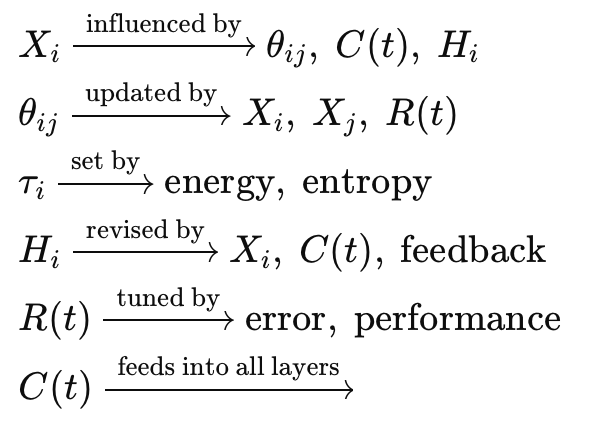What does it mean for a model to have a pulse, to cycle, to evolve through a living loop of interaction?
Introduction: Life is a Cycle
Every living system breathes in cycles:
- The heart beats; the lungs inhale and exhale.
- Forests pass from growth to decay and back again.
- Societies shift from stability to upheaval and return to calm.
DAM X embodies this philosophy in mathematics:
It is not a linear chain of events, but a loop, where each part feeds into the next—creating a self-sustaining, ever-adapting rhythm.
The Full DAM X Update Cycle
At every time step, DAM X performs a dance of adaptation—a layered loop—with each stage influencing all others:
1. State Update (Xi(t))
Each entity updates its state, considering:
- Its current value.
- Its neighbors (network connections).
- The influence of context and past errors.
2. Network Evolution (θij(t))
The web of relationships shifts:
- Stronger or weaker ties based on mutual influence and recent events.
- New links can emerge; old ones can dissolve.
3. Internal Time Flow (τi(t))
Each part of the system may speed up or slow down:
- Time is not fixed; it adapts based on energy, entropy, or surprise.
4. Goal Adjustment (Hi(t))
Goals are reassessed:
- Success or failure may prompt a change in direction.
- External context or internal stress can trigger new priorities.
5. Rule Evolution (R(t))
Even the rules of change can change:
- Learning rates, adaptation strategies, and model architectures can be re-tuned.
- The system can “learn how to learn,” improving its own plasticity.
6. Error Measurement and Learning
Outcomes are compared to expectations:
- Errors fuel further adaptation (as in the previous section).
- The loop tightens or loosens based on feedback.
7. Context Sensing (C(t))
The environment is continually monitored:
- Sudden shocks or gradual trends may trigger instant adaptation or slow recalibration.
All Layers Interact: No Step in Isolation
The magic of DAM X is that no layer acts alone:
- A change in context ripples through states, networks, goals, and even learning rules.
- A surprising error can alter not just parameters, but the very structure of adaptation.
- Time itself can compress or expand in response to collective dynamics.
This recursive, multi-layered feedback loop is what gives DAM X its living quality.
A Schematic View of the DAM X Organism
At each time step:

Sample Algorithm: One Cycle in DAM X
python
def damx_cycle(X, theta, tau, H, R, C):
# 1. State Update
X = update_states(X, theta, C, H, R)
# 2. Network Evolution
theta = update_network(theta, X, R, C)
# 3. Internal Time Flow
tau = update_time_flow(X, theta, C)
# 4. Goal Adjustment
H = update_goals(H, X, C, R)
# 5. Rule Evolution
R = update_rules(R, X, theta, H, C)
# 6. Error Measurement and Learning
error = compute_error(X, predicted_X)
adjust_learning(error, X, theta, H, R)
# 7. Context Sensing
C = sense_context(C, X, theta)
return X, theta, tau, H, R, CA Living Loop: The Breath of Adaptation
Just as a heart beats or a city pulses with daily rhythms, DAM X cycles through sensing, reacting, learning, and re-inventing.
- The loop is not rigid; it stretches, contracts, and even changes shape as needed.
- The system is never done: it is always returning, always re-examining, always moving.
Why a Loop?
Linear models get stuck—unable to revisit, unable to grow.
DAM X lives because it loops:
- Feedback is not just a correction—it is a creative force.
- Cycles allow for memory, anticipation, and emergent intelligence.
To model life, we must let our mathematics loop, breathe, and dance.